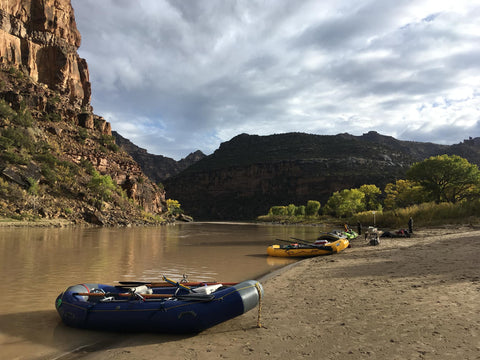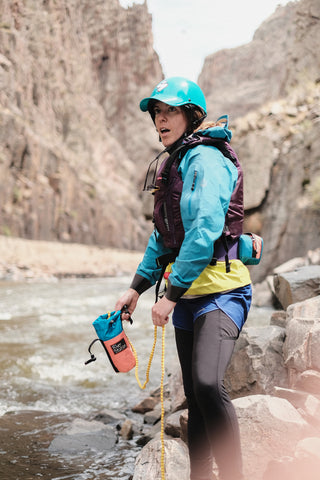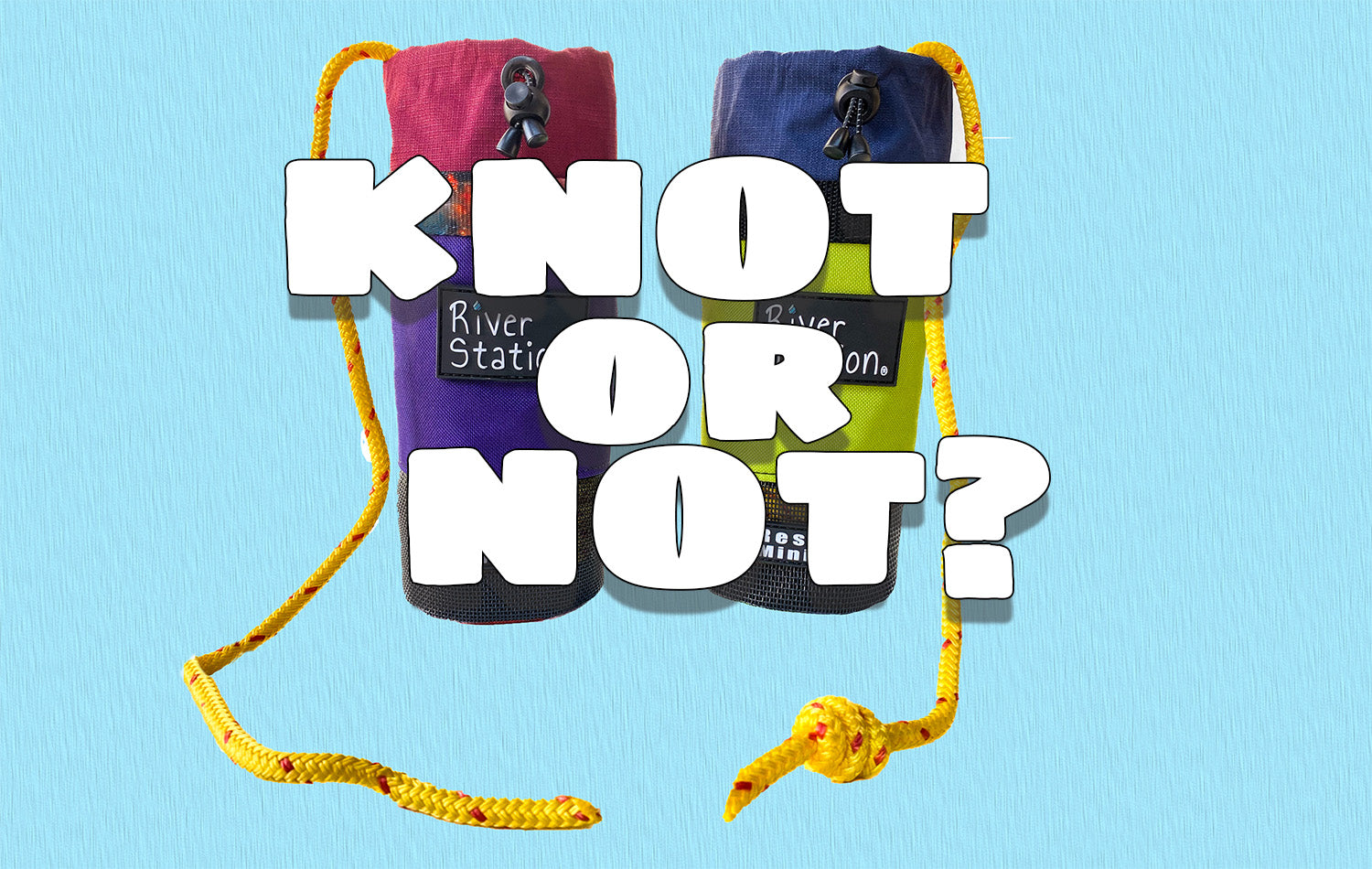According to Colorado Parks and Wildlife regulations, “every regulated trip carries…a throw bag containing a minimum of fifty feet of rope.” Throw bags are required safety equipment for commercial whitewater rafting. However, there are no requirements for when or how to use your throw bag.
For example, some guides prefer to have a knot at the end of their throw rope, and others prefer a clean line. This personal preference is often the subject of heated debate. To learn more about this division in our river community, we reached out to guides, private boaters, Swiftwater Rescue, and industry experts.

Guides and Private Boaters
Guides and private boaters consistently prefer keeping a knot at the end of their throw rope. This information comes from a number of highly official polls conducted on social media that show 60-70% of respondents have a knot at the end of their throw bag.
(Again, these were super official. Some guides admitted to not having a throw bag at all, and others reported they had knots throughout their ropes, officially.)
The primary reason for having a knot is to keep from slipping off the synthetic material when the line is weighted. The knot can act as a stopper for your hands. Some guides keep a knot outside the barrel lock drawstring, so it’s easier to find in a rescue situation.
The reasons for not having a knot in the throw bag were summed up in this Facebook comment: “Knots get let go of in the river. Knots hang up on rocks and become underwater hazards that have killed many. Such a preventable death.”
Ropes can pose a serious entanglement hazard when misused or things go wrong. However, have they killed “many?” We turned to the experts to find out more.

Experts
The experts we spoke to are similarly divided on this issue. Some are adamant about having a knot-free rope bag, and others acknowledge the benefits of either option.
Nouria Newman, Professional Kayaker
Nouria Newman, the best kayaker in the world, is adamant about never having knots in her throw bags. In response to our Instagram poll, she said, “I just simply don’t even know why people keep loops and knots on their rope. A rope is only useful as long as it doesn’t create more danger.” Adding, “This is a non-question for me, and I can’t believe this is still a question in the paddling community.”
For Nouria, the only loop or knot on a throw bag should be on the side of the rope bag, and so small only a carabiner fits through. The working end should be knot-free; otherwise, there is a potential for knots and loops to entrap a swimmer.
To address the stopper knot argument, Nouria reminds us that “If you’re not holding [the rope,] it’s because you’re not in a stable position. And so that’s something you should be looking for before throwing a rope… if you don’t have a good place to set yourself, it’s useless.” She also advocates for “before you throw you keep[ing] a meter behind your hand in case it slides.”
To those who enjoy the convenience of a pre-made knot for quickly clipping carabiners to the end of your rope, Nouria says, “You don’t need to have a loop and a knot if you know how to make fundamental knots. You should be able to make a bowline or cabestan knot (clove hitch) at any time, super fast.”
Matt McDonough, Swiftwater Rescue Instructor
With 20+ years of experience running rivers and teaching swiftwater rescue class, Matt McDonough doesn’t have a knot at the end of his throw bag. His reason: “I would rather have the rope slip through my hand than have the knot cause me to grab harder and possibly endanger myself.” He keeps a handle on his line by being “mindful of the amount of rope I have out and left.”
Matt’s reason was not that knots might get stuck and create entanglement risks, saying a throw bag becoming “lodged due to a knot is very unlikely.” Although Matt is on the no-knot team, he validates both sides of the argument and each personal preference.

Rope-related Accidents
Team No-Knot often cites rope-related deaths and accidents as a reason to keep their throw bag lines clean. But how common are they? We scoured the American Whitewater Accident Database for more information. Here’s what we found.
Rope-related accidents are listed under “equipment trap” and account for thirty-four fatalities out of the nearly 2,000 reported in the database. “Equipment trap” includes getting caught by PFDs, carabiners, SUP board leashes, or fishing waders.
Of the thirty-four reported equipment trap fatalities, ten involved ropes. The rope-related fatalities include boaters getting snagged in abandoned ropes, getting stuck to lines coming off their raft, getting stuck by a waist belt, or getting their limbs tangled up.
Of the fifteen reported close calls, seven involved ropes. The accident database doesn’t have any reports of injuries or deaths resulting from a hand in a throw bag loop. Although Charlie Walbridge, who maintains the database, admits they “only get a small sampling of close calls and injuries.”
Only one incident report specifies that a knot was responsible for rope entanglement. It’s hard to say if the other snagged ropes caught on a knot or just did what rope does and got snarled up.
Rope Safety
Reading accident reports is never fun, but it is a good reminder of how quickly things can go wrong. Whether you have a knot at the end of your throw bag, ropes, and moving water can create dangerous situations. Here are a few rope safety tips to follow.
Remove and Report Ropes
When a rope does get stuck, do everything you can to remove it. Sometimes a rope simply won’t budge, making it impossible to retrieve. In these cases, cut it as close to the point of entanglement as possible.
Your next step should be to report the location of the rope. Call around to the river rangers and local outfitters. Report the rope online in Facebook Groups, submit a report to American Whitewater, or leave a high visibility notice at the put-in. Whatever it takes to ensure the community knows of the potential hazard.
Always Carry a Knife
A river knife is as essential as a throw bag, and every boater should carry one. A line under tension might become impossible to untie, untangle, or move. These lines have to be cut. Many of the “close call” reports would have been fatalities had no one had a knife.
Besides throw bags, knives can cut perimeter lines, a waist belt, and other entanglement hazards like kayak skirts. Plus, they are perfect for spreading peanut butter.

Practice Throw Bagging
Find a calm stretch of moving water with high visibility, a couple of buddies, and practice throw bagging each other. Take turns being the swimmer and the rescuer, and make sure you have the right throw bag. If you don’t have moving water (or friends), practice on dry land. Any practice aiming with your throw bag will result in smoother throws.
Practice a variety of throws. For example, overhand, underhand, and side arm for limited space. Practice the coil throw as well. If you miss with the first throw, re-coil a few meters of rope and throw the coil. A good coil throw can be as effective as tossing a bag, but only if you practice.
Repack Your Throw Bag With Care
When you repack your throw bag after a practice session or a whitewater rescue scenario, pack it carefully so the coils of rope stack on top of each other. This ensures the bag will uncoil without any knots or tangles. The last thing you want is a mess of rope stuck to the internal foam flotation that doesn’t flake out to your swimmer.
Final Thoughts
Throw bags are life-saving equipment. Regarding the knot vs. no knot debate, there is no right or wrong answer. Knots can get caught up on things, but so does rope in general. Having a stopper knot can help you hold on, but so can starting with enough rope and making sure you’re in a stable position.
Are you Team Knot or No Knot? Let us know in the comments, and don’t forget to share this with your boating crew. S.Y.O.T.R
By: Megan Young McPartland


Share:
3 Essential Bags for Whitewater Rafting.
5 Ways to get Involved in your Local Whitewater Community
2 comments
coming from a climbing background a knot at the end to anchor to something seemed right. will give this some thought after reading the article.
The official training from British Canoeing is NO knots, i.e. the “clean line” or “clean rope” principle.
https://britishcanoeing.org.uk/uploads/documents/White-Water-Safety-and-Rescue-Training-Course-Notes-Dec17.pdf
Note that the bag should have a tiny loop (as per Nouria’s comments) for a carabiner otherwise the swimmer is tempted to put a hand or even a finger in it – with the potential for serious physical injury.
Note that the latest carabiner recommendations are ONLY for twist-gate type on throw lines (for example if doing a “live-bait” style rescue) as in a rescue with multiple lines in the water there is a risk of the rescuer being snagged on existing lines.